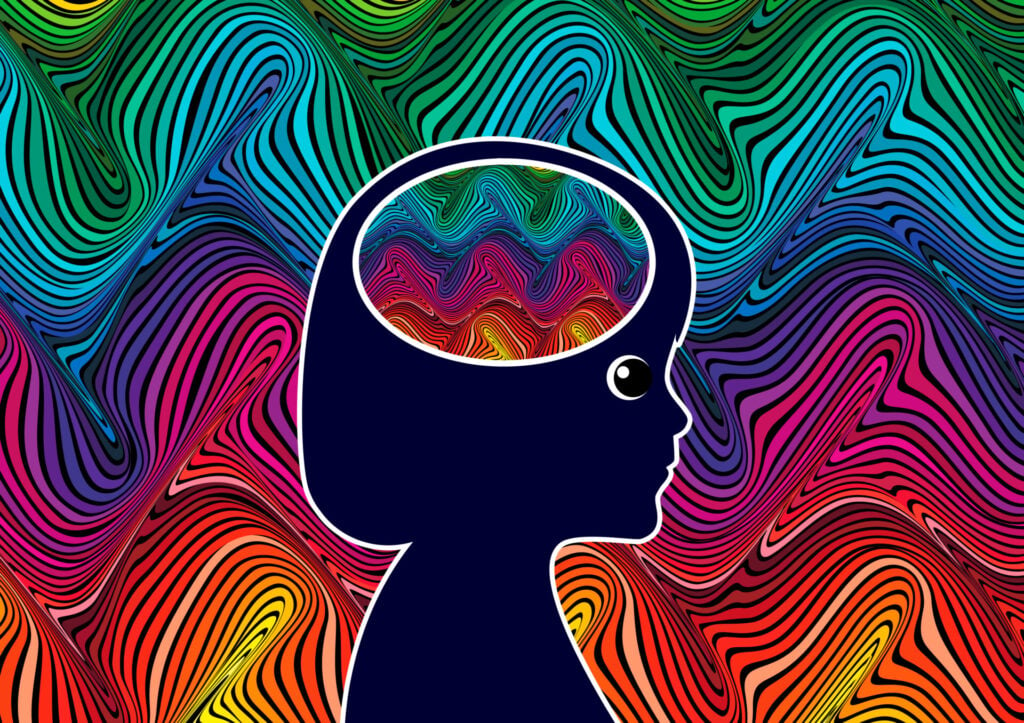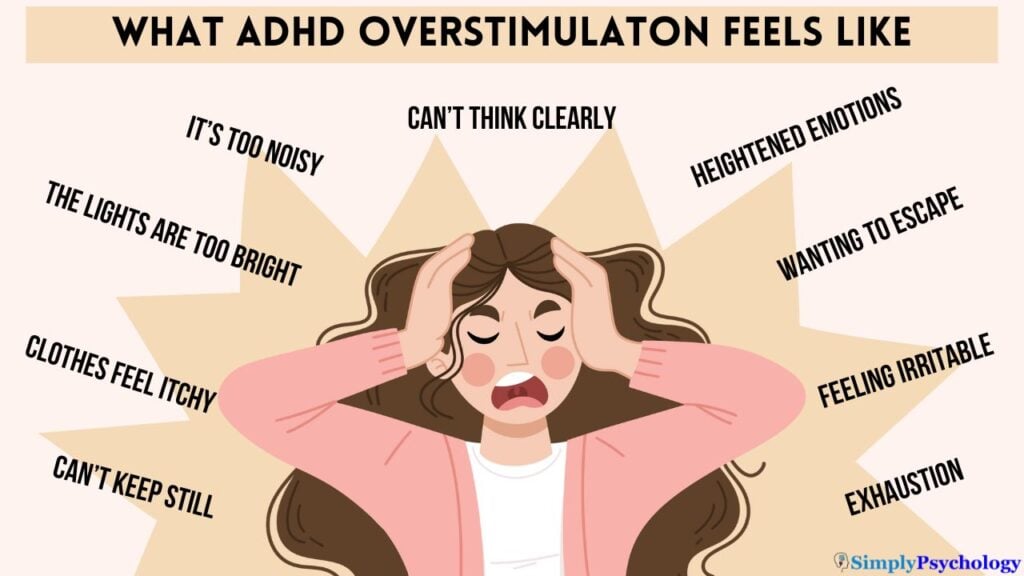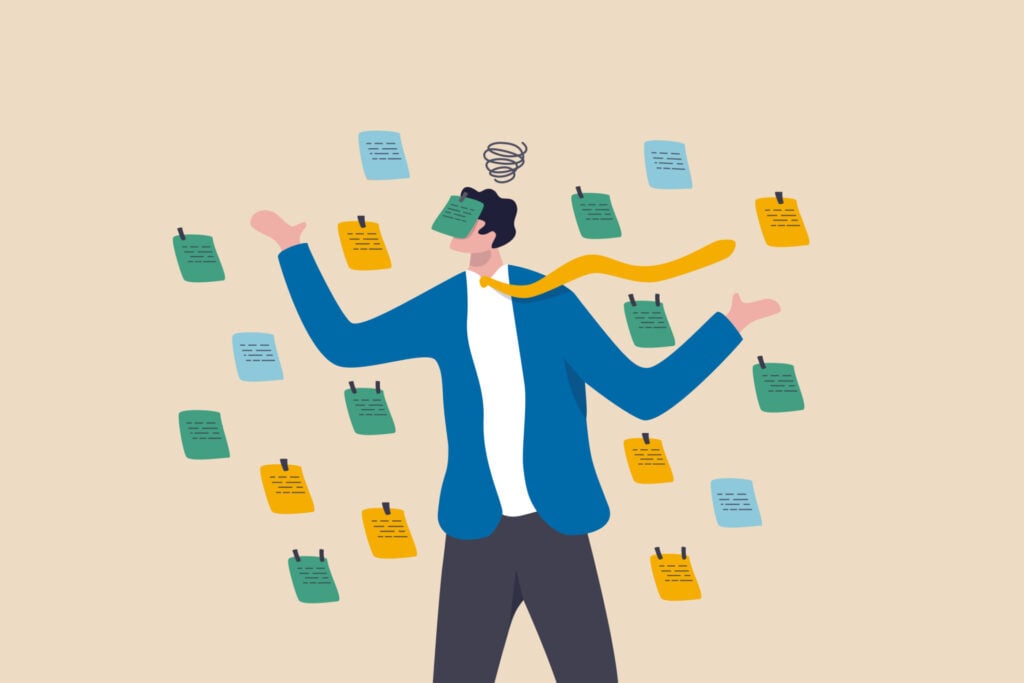On This Page:
ADHD overstimulation is a state of heightened sensory, cognitive, or emotional arousal. It can occur when a person is either overwhelmed by environmental stimuli from their surroundings or internal input (Sikström & Söderlund, 2007).
The failure to efficiently filter, process, and control this influx of sensory and cognitive information can generate challenges.

Signs of Overstimulation in ADHD
ADHD overstimulation can manifest as several emotional and behavioral responses. Here are some of the most common signs:
- Sensory and emotional sensitivity, e.g., strong reactions to loud noises, bright lights, or intense reactions to criticism and negative feedback.
- Anxiety and stress, e.g., in specific social situations, crowded environments, or when having more challenging discussions.
- Restlessness and impulsivity, e.g., tendencies to fidget and react quickly without thinking things through.
- Emotional outbursts, e.g., intense crying fits, yelling, or even overexcitement.
- Cognitive overload and feeling unable to cope, e.g., feeling overwhelmed, unable to focus or complete tasks, increased stress, and feeling dread.
- Fatigue and overall physical and emotional exhaustion, e.g., feeling burned out, tendencies to shut down, and overall experiencing mental and physical tiredness.
- Information processing challenges, e.g., difficulty task switching, absorbing information, or remaining concentrated on the material.
What Does ADHD Overstimulation Feel Like?
Toby Shaw, in his TedTalk titled “ADHD from the inside,” describes the feeling of ADHD overstimulation as follows:
“Picture a big city and I want you to picture it in the intersection. You’ve got all these things going on: you’ve got buses, you’ve got cars, you’ve got people talking, you’ve got sounds, you’ve got all these things going on and it’s overwhelming. And I want you to imagine that sense of confusion and having that on a daily basis”.
As we can see, ADHD overstimulation can feel extremely overwhelming and disorienting. Let us discuss in more detail some of these most common ways it can feel:

Restlessness
An intense and persisting restlessness may be a symptom of ADHD overstimulation (Weyandt, 2003). It is like constantly having an itch that will not go away or an irrational amount of internal energy.
You might be tempted to fidget, tap your fingertips, or move around a lot.
Your body may seem to demand movement, even if it is only something simple like shifting in your seat, and staying motionless while you are sitting can feel extremely difficult.
When you are in a scenario that calls for composure and concentration, this restlessness can be especially aggravating as it can make you feel on the edge, both physically and mentally.
Extreme Discomfort
Extreme discomfort can arise as you are overloaded with sensory data all at once (Ramsay, 2016).
Overstimulation can cause you to become more perceptive of your environment and make normal sensations seem overpowering. For example, it is possible for lights, noises, and textures to appear overly strong.
This intense discomfort may manifest as if your senses are in overdrive and you can not find relief coupled with difficulty feeling at peace, e.g. if everything around you seems to be turned up to an unpleasant volume.
Panic
When you are overstimulated, you could feel panicky and as though your body’s fight-or-flight response has been activated. It is comparable to being in a crowded space where the noise level peaks, and you immediately want to leave.
Physical and emotional symptoms of this anxiety are highly possible, e.g., you can experience an increase in heart rate and trouble breathing.
Feelings of imminent disaster or a pervasive feeling of being emotionally overwhelmed can also occur. This intense panic response can make it difficult to think or reason clearly, further exacerbating the sense of being overwhelmed.
In some cases, these symptoms may even progress to a panic disorder (Krone & Newcorn, 2015).
Physical and Mental Exhaustion
Overstimulation can paradoxically make you feel both energized and completely fatigued. You may feel exhausted from the effort your body and brain make to process the stream of sensations.
Even if you have not moved physically, it can feel like running a marathon in your head. This fatigue affects not just the physical body but also the mind, heart, and spirit.
You may notice that you lose the capacity to focus or participate in activities, leaving you feeling mentally fatigued. It may also seem as though you have run out of cognitive capacity while attempting to process the stimuli in your environment.
‘One of the keys always behind when I get overwhelmed is that I’m doing too much. This is despite the fact that even when I have too much on my plate, it always feels like I should be doing more, that I could squeeze in a few more things and then, well, then I’d probably still try to add a few more things.’
William Curb, host of ‘Hacking Your ADHD’ podcast
Headaches
Overstimulation-related tension frequently results in headaches (Salem, 2018). This discomfort can be made worse by the interaction of sensory overload, heightened emotions, and restlessness in the body.
These headaches could present themselves in varied ways but usually, they are either severe or dull and most often chronic.
They are typically localized across your forehead or concentrated around your temples.
These headaches are often a direct reflection of your current level of overstimulation in terms of severity, so the more overstimulated you are, the worse the headache.
Energy Surges and Crashes
Energy surges and crashes from ADHD overstimulation can resemble a roller coaster with rapid ascents and descents. Your energy may spike at first as your brain attempts to process everything around you.
But over time, this surge can cause physical and mental tiredness, leaving you exhausted and depleted.
This upward and downward fluctuation in energy levels can happen either at a daily and/or weekly level.
They can also be situation-dependent, e.g., less likely to happen inside the house or someone’s safe space vs. outside, where there are more chances for overstimulation.
What are Meltdowns and Shutdowns?
Meltdowns and shutdowns can be defined as intense emotional and behavioral responses that individuals with ADHD can experience.
These typically manifest when overwhelmed by either sensory, cognitive, or emotional stimuli (Mayes, Calhoun, Mayes & Molitoris, 2012).
Meltdowns are extreme emotional outbursts that can include yelling, sobbing, smashing objects and often combine physical actions with intense uncomfortable feelings such as anger, frustration, sadness, or panic.
Thus, when a person has a sensory or emotional overload that is too much for them to bear, a meltdown occurs.
Shutdowns are disengagement from interactions and external stimuli. A shutdown can cause a person to withdraw and seem distant from their environment (Spaeth, 2022).
This serves as a coping strategy to control overstimulation and give the person a “break” from what is happening around them.
What Can Cause Overstimulation in ADHD?

ADHD overstimulation can not only cause several mental and physical challenges but may also permeate into other areas of one’s life. Let us look in more detail at some of the most frequent areas of manifestation and impact.
Oversensitivity
A person with ADHD can have increased sensitivity to environmental stimuli (Panagiotidi, Overton & Stafford, 2018).
Consequently, common sensory inputs such as light, sound, touch, smell, taste, and even social interactions might be felt as being amplified or overwhelming.
As the brain tries to analyze and filter this incoming data, overstimulation can directly result in oversensitivity. For instance, someone with ADHD may become overstimulated by a mildly noisy situation that others may find tolerable.
Executive Dysfunction
Executive functions, which include abilities like working memory, decision-making, and attention management, can operate differently in ADHD (Barkley, 1997).
For example, it may be more challenging to manage numerous tasks at the same time, weed out unimportant information, and maintain concentration when these skills are impaired.
As a result, situations where several tasks or inputs must be balanced may quickly result in cognitive overload and overstimulation. For instance, someone with executive dysfunction can find it difficult to follow directions in a busy setting.
ADHD coach Caren Magill explains how ‘time blindness’ is an executive dysfunction in people with ADHD. This can include always being late or not noticing the passage of time, which can lead to rushing.
‘When you’re rushing, you’re not really paying attention to what you’re doing, you tend to make more mistakes, you lose things, you say things you don’t mean or agree to things you shouldn’t, and you just generally feel overstimulated… So if anything adds on top of that, you’re more than likely going to hit your threshold really quickly.’
Caren Magill, ADHD Coach
Emotional Dysregulation
Emotional dysregulation refers to difficulty managing and responding appropriately to emotional experiences, often leading to extreme reactions.
In ADHD, emotional dysregulation may arise from imbalances in neurotransmitters, such as dopamine, which is involved in the reward and attention regulation pathways (Blum et al., 2008).
Certain deficits in executive function may also be present in association with ADHD (Brown, 2009), which then affect impulse control and emotional regulation.
These neurological differences can make it challenging to modulate emotional responses, thus resulting in reactions that may appear disproportionate or inappropriate.
Emotional dysregulation frequently involves strong and unpredictable emotions (Shaw, Stringaris, Nigg & Leibenluft, 2014).
Even minimally stressful situations can result in powerful emotional reactions when feelings are high. Overstimulation can thus occur quickly as a result of this intensity and problems with emotional regulation.
For example, someone who struggles with this may experience an excessive emotional reaction when receiving constructive criticism that may otherwise be manageable for others, which can lead to overstimulation.
Task Complexity
Complex jobs requiring careful planning and decision-making can be too much for those with ADHD to handle.
Due to their cognitive resources being under more pressure as task complexity rises, this overstimulation can increase both sensitivity and emotional sensitivity, which can thus lead to overstimulation.
This susceptibility can also be increased by cognitive exhaustion brought on by completing challenging activities in difficult circumstances.
‘We tend to take on too much because we don’t think about how long things will take. So we agree to do too much, we want to do too much, and that leads us into a state of overwhelm.’
Caren Magill, ADHD Coach
How to Cope with ADHD Overstimulation
ADHD overstimulation can impact several areas of life, so knowing how to manage symptoms can positively impact both day-to-day living as well as interpersonal relationships.
Let us look at some ways you can implement and hopefully cope better with overstimulation-related challenges:
Identify the triggers
The first step in managing ADHD overstimulation is to pinpoint the precise triggers that result in these difficult situations.
You can begin considering everything from the circumstances, surroundings, and/or activities that frequently lead to overstimulation.
This could include social circumstances, busy areas, noisy environments, multitasking, or other factors. By doing so, you can then proactively begin to handle these triggers as you are better aware of them.
Gain control over triggers
Once you have determined the triggers, try to slowly begin to avoid them whenever you can. For example, this could look like making adjustments to your routine or environment as necessary.
Additionally, consider wearing noise-canceling headphones or choosing quieter areas, for instance, if loud situations trigger you. You can lessen the possibility of overstimulation by taking precautions to limit exposure to triggers.
Sleep schedule
It is essential to keep a regular sleep schedule if you want to control overstimulation. Your brain needs sleep to recover and to help control how your senses are processed. A lack of sleep can have negative impacts on these alongside executive functions (Gruber et al., 2011).
Thus, make getting adequate sleep each night a priority and establish a good nighttime ritual that encourages unwinding and restful sleep. For example, a sleeping mask, listening to white noise, having your phone on silent, etc.
Consequently, the capacity of your relaxed mind to process sensory information without becoming overwhelmed will slowly begin improving.
Develop a routine
Developing a routine can help provide structure, monitor activities, and create a sense of consistency.
You can begin by writing down a schedule, either daily or weekly, and note down activities you frequently engage in. Utilize this space to block time for goals you want to achieve and ensure you leave time for breaks.
Adding some buffer times as well may be beneficial so your routine can remain agile and flexible. By incorporating this routine, you can begin better managing sensory stimulation more effectively and generate a sense of control over environmental triggers.
ADHD coach Tara McGillicuddy explains that when she is working with people, she reminds them to ‘Only focus on the one thing they’re working on… break it down into actionable steps.’ She adds, ‘If you are overwhelmed… create some structure in your own life.’
Identify safe spaces
Ensuring you have a calm, private, and accessible space to go to when overstimulation happens is key. Therefore, you can begin to identify safe spaces in your most frequented areas.
For example, this can range from a room in your house where you feel relaxed or a quiet corner in the office where you can retreat and decompress.
Feel free to add elements to this environment that help you calm down, such as items in your favorite colors, textures, or scents. You can keep items like these with you on the go to create mobile safe spaces when you are out in the community and away from your nearest identified safe space.
Have regular ‘cool downs’
Include periodic “cool-down” or rest intervals in your day to allow yourself to unwind and prevent shutdowns. For example, you can step away from potentially stressful circumstances during these periods to regroup.
Find a place that is peaceful so that you can practice soothing techniques like deep breathing, mindfulness exercises, or even just closing your eyes for a while.
These brief rest periods can act as a protective mechanism and keep sensory overload from both developing and escalating.
Adapt and adjust
Instead of getting rid of the triggers completely, try to modify your surroundings to meet your sensory needs. Some examples of these are rearranging your desk, utilizing task organizers, or creating designated quiet spaces throughout your home.
Overstimulation can be considerably decreased by designing an environment that has such measures put in place to either help avoid escalations entirely or minimize their intensity.
Self-soothing
Create self-soothing techniques to help you deal with overstimulation when it arises. These methods could involve grounding exercises, progressive muscular relaxation, and deep breathing exercises (Bueno et al., 2015).
Each person is different in what works best for them, so try out various methods to see which one aligns with you the best.
By finding a go-to technique for soothing yourself, it can then be easier to restore control in stressful situations if you have a mechanism in place you know you can resort to when needed.
Find supportive relationships
Supportive relationships can help adults with ADHD who are feeling overwhelmed or overloaded in their daily lives.
Specifically, research has found that having interpersonal and professional relationships is essential for helping manage daily life. Friends and family can provide support and guidance in coping with ADHD symptoms. Relationships also provided accountability – having someone to turn to for help when needed.
Relationships with healthcare professionals could also be beneficial when there is collaboration and ongoing guidance about things like medication adjustments. This active support from a provider can ease the burden on the individual trying to manage their ADHD independently (Becker et al., 2023).
Overall, having people to turn to likely prevents feelings of overload from becoming unmanageable for those with ADHD.
Relaxation techniques
Utilize relaxation techniques in your regular activities to control stress and avoid overstimulation. Some popular methods are yoga (Lange, 2014), meditation, and mindfulness, which can help your sensory processing and aid in emotional response regulation.
You can begin on a weekly basis and increase the frequency to even daily if needed or desired. By employing such strategies, you will encourage serenity and possibly raise your general resistance to sensory overload.
Consider professional help
Lastly, you might find it helpful to seek professional assistance if overstimulation constantly disrupts your daily life.
To manage overstimulation and its effects on your well-being, a mental health professional, such as a therapist, ADHD coach, or psychiatrist, can offer customized techniques and coping mechanisms.
Additionally, they can aid in addressing any underlying emotional or psychological issues that may be linked and exacerbating your overstimulation.
FAQs
What is the cause of ADHD overstimulation?
Neurobiologically, the way people with ADHD process information in their brains is frequently different, especially in regions associated with attention, sensory perception, and emotional control (Shaw, Stringaris, Nigg & Leibenluft, 2014).
They might, therefore, be more vulnerable to being overwhelmed by stimuli that don’t generally disturb neurotypical non-ADHD individuals as much. For example, being in a loud, brightly lit office with lots of overlapping ongoing conversations and/or noises.
What is the difference between overstimulation and understimulation?
Overstimulation is a state in which a person’s sensory, cognitive, or emotional stimuli surpass their ability to effectively integrate and manage their feelings (Frankenhaeuser, Nordheden, Myrsten & Post, 1971).
Restlessness, feeling overwhelmed, and overall intense emotions may result from this. Overstimulation frequently happens in settings with high sensory input or when performing activities that call for a lot of focus and attention.
It can often lead to restlessness, difficulty focusing, and even severe discomfort.
Understimulation happens when a person receives insufficient sensory or cognitive input. This could make someone feel bored, restless, or like they need some more stimulus.
Understimulation frequently happens when there is not enough novelty or difficulty to hold someone’s interest. Those who are understimulated may look for activities that are more stimulating, as the lack of involvement can make it difficult to stay motivated and focused.
Is overstimulation always a sign of ADHD?
Overstimulation can happen in various situations and even among people who do not have ADHD. This can include neurotypical people and other neurodiverse individuals such as those who are Autistic.
Anyone can get overstimulated by circumstances outside themselves, such as overly exciting surroundings or environmental stimuli, e.g., a crowded concert.
However, people with ADHD can be more susceptible to overstimulation due to their heightened sensory responses and challenges in controlling stimuli.
Are overstimulation and hypersensitivity the same thing?
Although related terms, overstimulation and hypersensitivity mean different things.
Heightened sensitivity to sensory stimuli is referred to as hypersensitivity. This implies that hypersensitive people may receive sensory input more strongly than others.
Contrastingly, excessive sensory, cognitive, or emotional input that exceeds a person’s ability to efficiently handle it causes overstimulation. Overstimulation can be caused by hypersensitivity, but it also results from sensory overload.
Can overstimulation feel like a panic attack?
In terms of the intensity of the physical and mental symptoms, overstimulation and panic attack episodes can be comparable, but their causes and mechanisms differ.
Overstimulation is a reaction to an individual’s processing capacity being surpassed by an overwhelming amount of sensory, cognitive, or emotional input. This may result in restlessness, impatience, and a sense of helplessness.
In comparison, panic attacks are episodes of extreme dread or worry that can cause physical symptoms, including a racing heartbeat, shortness of breath, and a sense of impending doom.
Even while there may be some similarities in physiological reactions, the underlying reasons and emotional states are separate.,
Do people with ADHD get overstimulated easily?
People with ADHD can indeed be more prone to overstimulation because of their heightened sensory sensitivity and difficulties controlling stimuli.
Their brains might have trouble effectively filtering and processing sensory, cognitive, or emotional information, which can make them more susceptible to feeling overloaded.
For those with ADHD, commonplace situations that would not normally cause overstimulation could have a higher effect. It is thus crucial to remember that people with ADHD have different levels of susceptibility to overstimulation.
Lastly, some people might encounter it more regularly or intensely than others, while for others, it may not impact them that significantly.
References
Barkley, R. A. (1997). Behavioral inhibition, sustained attention, and executive functions: constructing a unifying theory of ADHD. Psychological bulletin, 121(1), 65.
Becker, P., Rask, M., Safipour, J., & Gunnarsson, A. B. (2023). Selfcare Strategies Shown to Be Useful in Daily Life for Adults Diagnosed with Attention Deficit Hyperactivity Disorder–A Systematic Review. Issues in Mental Health Nursing, 1-9.
Blum, K., Chen, A. L. C., Braverman, E. R., Comings, D. E., Chen, T. J., Arcuri, V., … & Oscar-Berman, M. (2008). Attention-deficit-hyperactivity disorder and reward deficiency syndrome. Neuropsychiatric disease and treatment, 4(5), 893-918.
Brown, T. E. (2009). ADD/ADHD and impaired executive function in clinical practice. Current Attention Disorders Reports, 1(1), 37-41.
Bueno, V. F., Kozasa, E. H., da Silva, M. A., Alves, T. M., Louzã, M. R., & Pompéia, S. (2015). Mindfulness meditation improves mood, quality of life, and attention in adults with attention deficit hyperactivity disorder. BioMed Research International, 2015.
Curb, W. (Host). (2023, August 7). Too Much (rebroadcast). In Hacking Your ADHD.
Frankenhaeuser, M., Nordheden, B., Myrsten, A. L., & Post, B. (1971). Psychophysiological reactions to understimulation and overstimulation. Acta Psychologica, 35(4), 298-308.
Gruber, R., Wiebe, S., Montecalvo, L., Brunetti, B., Amsel, R., & Carrier, J. (2011). Impact of sleep restriction on neurobehavioral functioning of children with attention deficit hyperactivity disorder. Sleep, 34(3), 315-323.
Krone, B., & Newcorn, J. H. (2015). Comorbidity of ADHD and anxiety disorders. Attention-deficit hyperactivity disorder in adults and children, 98.
Lange, K. M., Makulska-Gertruda, E., Hauser, J., Reissmann, A., Kaunzinger, I., Tucha, L., … & Lange, K. W. (2014). Yoga and the therapy of children with attention deficit hyperactivity disorder. Yoga & Physical Therapy, 4(3), 1000168.
Magill, C. (Host). (2023, May 19). Overstimulation in ADHD – How to avoid meltdown mode [Audio podcast episode]. In It’s The ADHD-Friendly Show | Personal Growth, Well-Being and Productivity for Distractible Minds.
Mayes, S. D., Calhoun, S. L., Mayes, R. D., & Molitoris, S. (2012). Autism and ADHD: Overlapping and discriminating symptoms. Research in Autism Spectrum Disorders, 6(1), 277-285.
McGillicuddy, T. & Edris, L. (Hosts). (2021, June 30). Time Estimates & ADHD [Audio podcast episode]. In ADHD Support Talk Radio.
Panagiotidi, M., Overton, P. G., & Stafford, T. (2018). The relationship between ADHD traits and sensory sensitivity in the general population. Comprehensive psychiatry, 80, 179-185.
Ramsay, J. R. (2016). “Turning Intentions Into Actions” CBT for Adult ADHD Focused on Implementation. Clinical Case Studies, 15(3), 179-197.
Salem, H., Vivas, D., Cao, F., Kazimi, I. F., Teixeira, A. L., & Zeni, C. P. (2018). ADHD is associated with migraine: a systematic review and meta-analysis. European child & adolescent psychiatry, 27, 267-277.
Shaw, P., Stringaris, A., Nigg, J., & Leibenluft, E. (2014). Emotion dysregulation in attention deficit hyperactivity disorder. American Journal of Psychiatry, 171(3), 276-293.
Sikström, S., & Söderlund, G. (2007). Stimulus-dependent dopamine release in attention-deficit/hyperactivity disorder. Psychological review, 114(4), 1047.
Spaeth, E. (2022). Constant vigilance: a conceptualisation of the vigilance regulation model of ADHD in relation to learning and teaching in higher education.
Weyandt, L. L., Iwaszuk, W., Fulton, K., Ollerto
n, M., Beatty, N., Fouts, H., … & Greenlaw, C. (2003). The internal restlessness scale: performance of college students with and without ADHD. Journal of Learning Disabilities, 36(4), 382-389.


